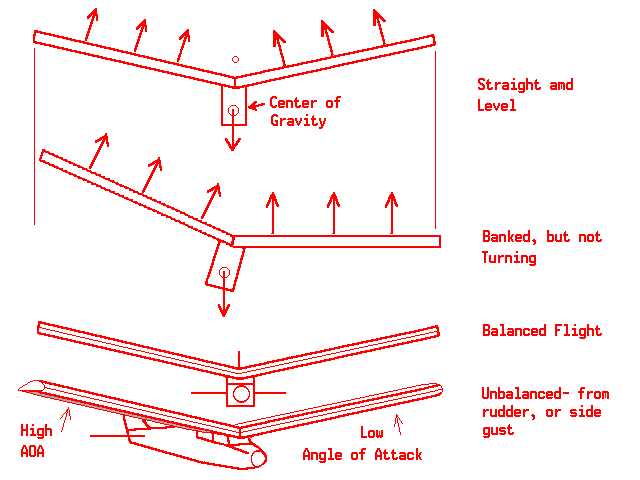
DIHEDRAL - How Much is Enough?
-by Clay Ramskill
Like most things in the aerodynamic world, the answer to the above question is- "it depends". It depends on what you want from your plane; how manuverable or how stable you wish it to be in the rolling axis, whether or not you desire the plane to roll when you deflect the rudder, whether or not you wish the plane to tend to self right when its upset from wings level.
In general, the more dihedral an aircraft has, the more it will tend to self-right to wings level when upset from straight and level flight. This little bit of roll stability makes the plane easier to fly because the pilot doesn't have to be constantly fighting to maintain wings level. Note the top two drawings in the figure - once we are no longer level, the lower wing is effectively a bit longer, and the lift forces forces on the lower wing are pointed more straight up. Also, since the figure shows a high wing plane, the CG of the plane is offset toward the high wing. All these situations tend to force the plane back to a wings level condition initially, before the plane begins turning or skidding sideways.
But the conditions described above won't last long. Also note that we now have the lift forces on the higher wing pushing sideways; this will cause the plane to skid sideways, turn, or both. Assuming no corrections from the pilot, what now happens is largely dependent upon the size of the rudder/fin combination! If the fin/rudder area is just right, the skid continues just enough for the dihedral effect of the wing to return us to wings level. Too much area in the fin/rudder, and we turn without skidding. Centripetal force from the turn negates all the self-righting effects, and we fly in balanced flight, but in an ever increasing wing and nose-down spiral - this is called spiral instability. Too little fin/rudder area, and the skid continues even as we pass wings level, resulting in over correction, and the plane rolls and skids, oscillating like a drunken sailor - this is called dutch roll.
Although the above discussion is more important to glider and free-flight pilots, it brings us to look at how dihedral affects a plane in skidding flight - and the good and bad sides of the dihedral effect. Note in the figure what happens to a plane with dihedral when in a skid, or unbalanced flight. This condition can occur with the pilots deflection of the rudder, or when a wind gust hits the plane from the side. The large discrepancy in angle of attack between the two wings causes the plane to roll away from the direction of the skid.

The dihedral effect is beneficial in self righting, gives us roll coupling with rudder application, and unfortunately, also gives us roll away from a side wind gust. Incidentally, sweeping a wing back also gives us dihedral effect - with about 5 degrees of sweep being equivalent to 1 degree of dihedral.
While roll coupling is essential to a trainer with no ailerons, its not good for aerobatic and combat aircraft. Most acrobatic and pattern models will have no dihedral. Military planes, with swept wings for speed, often use negative dihedral to counter the dihedral effects from the wing sweep - the Harrier, A7 Corsair, and C5 transport come to mind.
And while trainers usually have quite a bit of dihedral, and are wonderfully stable in normal flight, we've all seen them turn vicious in a gusty crosswind, during take off and landing, and even while taxiing on the field.
How much dihedral is enough?? For most of us, then, the answer is - Only enough to give us the roll stability we need, commensurate with our flying skills!
Site maintained by QSoftWorks
Last Update: 10/12/97